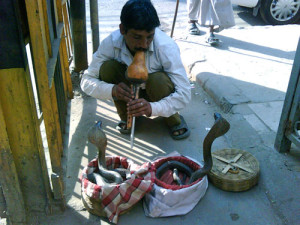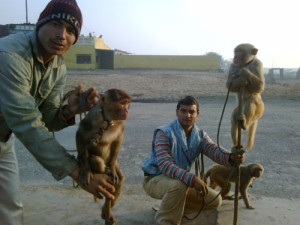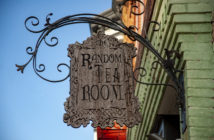Tea Lore
 Exotic India: known for its colorful saris, aromatic spices and golden palaces. In this birthplace of yoga, Ayurveda and Buddhism, it is no wonder that tea has developed such a prominent position. In India, tea is much more than a hot beverage, “It’s very simple, offering a cup of tea is what we call a commodity of friendship,” said Vipul Goel, A Cup of Chai, Brampton, Ontario. “ If you go to anybody’s house in India, the first thing you’re offered is a glass of water and the second thing is a cup of chai.”
Exotic India: known for its colorful saris, aromatic spices and golden palaces. In this birthplace of yoga, Ayurveda and Buddhism, it is no wonder that tea has developed such a prominent position. In India, tea is much more than a hot beverage, “It’s very simple, offering a cup of tea is what we call a commodity of friendship,” said Vipul Goel, A Cup of Chai, Brampton, Ontario. “ If you go to anybody’s house in India, the first thing you’re offered is a glass of water and the second thing is a cup of chai.”
The story of tea in India begins with the legend of Prince Bodhi-Dharma, a Buddhist monk who would eventually become the founder of Zen Buddhism. Devoted to spreading the word of Buddhism from India to China, Prince Bodhi-Dharma decided to give up sleep for nine years while making the journey. One version of the legend states, that after three years of being awake, the exhausted Prince chewed on the leaves of a nearby plant. The leaves of the plant, which he later discovered was a tea plant, allowed him to stay awake for the duration of the journey.
The Japanese version of this story is slightly different. In this legend, after three years of sleepless nights Prince Bodhi- Dharma falls asleep while praying. Frustrated, he cuts off his eyelids and burns them. From his eyelids sprouted a strange bush. Prince Bodhi-Dharma realized that eating the leaves allowed him to stay awake and continue with his mission. The bush that sprouted was of course a tea plant.
Tea has been deeply rooted in Indian history for centuries, initially used for both medicinal and spiritual practices. Common consumption of tea in India didn’t become widespread until the nineteenth century. It was 1833 and the British, worried about the potential loss of their source of tea from China, brought the precious Camellia Sinensis Sinensis (the native Chinese variety) seeds to India. However; the Chinese variety struggled to thrive. This is when the British discovered a naturally wild plant that resembled both the taste and aroma of the Camellia Sinensis plant from China, growing amongst the jungles of India. Camellia Sinensis Assamica thrived in the India terroir, producing a tea that would quickly become a worldwide favorite.
Tea Production in India
Today, tea grows throughout India, making it the second largest producer of tea. Each of India’s tea growing regions offers a unique profile, which are appreciated worldwide.
Meaning “one without equal”, Assam remains the largest tea production area for India. This tea is known for its rich malty flavor and is a wonderful base for common blends like English and Irish breakfast tea. The first Camellia Sinensis Assamica plants were believed to have been found in the jungles of the Assam region, a place that is home to the one horned rhinoceros.
In Nilgiri tea plants thrive at 1000 to 2500 meters, producing a delicate, lighter flavored tea. This tea is often described as a bright tea with floral notes, perfectly complementing the other teas in the area.
One of the more exclusive beverages for tea lovers is a cup grown exclusively from the leaves of Darjeeling. Grown between 600 and 2000 meters, the environment of the region offers the ideal elements to grow the Chinese variety (sinensis) of the Camilla Sinensis plant. Often lovingly referred to as the champagne of tea, to ensure the integrity of this tea, the Darjeeling name is now protected internationally. In order to receive the label of Darjeeling tea, not only does it have to be grown and processed in the region but also it has to conform to the distinct muscatel flavor profile that this tea is known for.
 A Cup of Indian Chai
A Cup of Indian Chai
In India the word chai simply means a cup of black tea that is often slowly brewed with the addition of milk and sugar. For traditional Indian households, brewing a cup of chai is an art, something not to be done hastily. The black tea leaves simmer slowly on the stove in milk and sugar throughout the day allowing the gentle aroma to penetrate the home. “A typical Indian chai is boiled black leaves with milk and sugar, that’s it,” said Vipul Goel, president, A Cup of Chai.
Although not mandatory, it has become fairly common for an Indian household to choose to enhance their tea with spices. The spices chosen will vary widely based on availability, season, health attributes or simply a family’s favorite recipe. Using Masala, a blend of spices, is also fairly common with the blends ranging once again according to household preference.
The use of spices in India can be traced back to India’s rich history of Ayurveda, a practice that recognized foods and spices interact with each body differently. “Ayurveda says that we don’t just metabolize food,” said Alan Marks, CEO, Maharishi Ayurveda Products International. “We metabolize our entire environment with every sense.”
In the beginning, spices might have been added simply to enhance the flavor of an over-brewed product. In the mid eighteen hundreds, when tea drinking really took hold in India, the leaves were extremely expensive. To save on costs, Indian households would often reuse tea leaves several times before discarding them.
“There’s a story I tell people, and don’t ask me whether it’s true or not. But when the British were in India they would have drank their brewed tea, leaving behind their black tea leaves,” said Goel. “The poor people would take those leaves, put them in milk and try to extract some flavor out of them by adding some spices–whatever was handy–and that’s how chai tea came to be. That’s my story.”
Today, households in India have adapted tea to incorporate a variety of flavor profiles, offering a warm beverage with enhanced wellness. “The tea drinking practices of India are as varied as its tea itself. Every place flavors their tea with different spices,” said Manish Shah, Maya Tea Company, Tucson, Ariz. “In the North East the spice of choice is typically lemon grass, while in Darjeeling and Nepal they drink straight black tea (not chai). In the south, they are more coffee drinkers and in the east, the spices used to enhance their tea tend to have more of an Oriental flavor.”
Brewing Your Own Cup of Chai
Why not adopt the beautiful practice of a cup of chai in your own home?
To begin, you will need a simple pot, black tea leaves and milk (or a nondairy alternative). The key to making an Indian chai is devoting the time for the tea to gently brew on the stove. Add the tea leaves directly to the milk and allow the aroma to penetrate throughout the house.
Now it’s time to add your own personal flair to your chai, choose whatever spices are your favorite and allow them to simmer in your brew. Some spice options are lemongrass, cardamom, vanilla, cloves or cinnamon, and even peppercorn. After allowing the tea to steep for several minutes, strain the tea leaves and sweeten the chai to taste.
Sip and savor.






